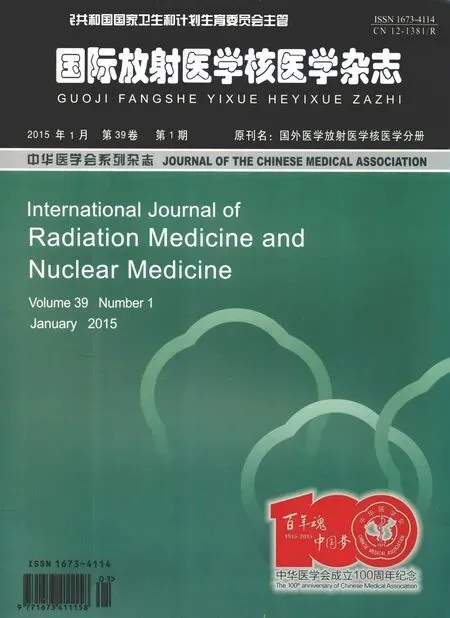动脉粥样硬化易损斑块放射性核素标记分子探针的研究进展
李帅 李剑明
动脉粥样硬化易损斑块放射性核素标记分子探针的研究进展
李帅 李剑明
动脉粥样硬化易损斑块破裂及随后发生的血栓形成和心肌坏死是急性冠状动脉(简称冠脉)事件发生的病理基础,急性冠脉事件的发生危险主要取决于易损斑块的组成成分而不是血管的狭窄程度。易损斑块具有如下特征:纤维帽较薄、炎性细胞浸润、细胞凋亡、斑块内出血及新生微血管生成。以凋亡细胞、巨噬细胞、氧化低密度脂蛋白、基质金属蛋白酶、组织因子、αvβ3整合素和微钙化为靶向的放射性核素标记分子探针已用于易损斑块的诊断研究,并表现出潜在的临床应用前景。
动脉粥样硬化;放射性同位素;分子探针;斑块
1 前言
动脉粥样硬化(atherosclerosis,AS)易损斑块破裂及随后发生的血栓形成和心肌坏死是急性心肌梗死、心源性猝死和急性血运重建等急性冠状动脉(简称冠脉)事件发生的病理基础。研究发现,急性冠脉事件的发生危险主要取决于易损斑块的组成成分而不是管腔的狭窄程度[1]。
近年来,已有多种影像学技术用于易损斑块的检测,包括冠脉造影、血管内超声、光学相干成像和温度测量法等,这些检查技术虽然能在一定程度上判断斑块的大致成分,但由于均为有创性检查,因此在临床上的广泛应用受到一定限制。电子束CT虽然在显示斑块钙化方面优势显著,但不能显示中等病变和无钙化斑块;冠脉CT造影虽然能无创性地显示冠脉管腔的狭窄程度和斑块负荷情况,并且对钙化和非钙化斑块显示较好,但仍然不能在早期明确区分易损斑块。因此,上述检查手段对于早期发现易损斑块有一定的局限性[2]。而放射性核素标记的分子探针作为一种无创性的检查手段,可以反映斑块的活性成分和内部的代谢信息,从分子代谢特征方面实现无创、简便、准确地探测易损斑块,为易损斑块检测提供了一种全新的手段。
2 诊断AS的放射性核素标记分子探针
易损斑块的主要特征是:纤维帽较薄或不完整、脂质核心占整个斑块体积的1/2以上、斑块内新生微血管和大量炎性细胞浸润、细胞凋亡以及斑块内出血。由于易损斑块的病理机制复杂,其标志物尚无统一定论,目前的研究认为,巨噬细胞、基质金属蛋白酶(matrix metalloproteinases,MMP)、氧化低密度脂蛋白(oxidized low density lipoprotein,OxLDL)、组织因子(tissue factor,TF)、新生微血管和斑块内微钙化对斑块的稳定性起着重要作用[3-4],现应用于临床或进行临床前药理评价的放射性核素分子探针主要以上述成分为靶点。
2.1 细胞凋亡显像
细胞凋亡是AS病变后期的主要特征之一,尤其是巨噬细胞凋亡被认为是导致斑块不稳定的主要因素。细胞凋亡后磷脂酰丝氨酸由细胞膜内侧移向外膜。由于Annexin V(膜联蛋白V)与磷脂酰丝氨酸具有高亲和力,采用放射性核素标记Annexin V进行细胞凋亡显像,可间接地反映体内血管发生的AS病变[5]。
Kolodgie等[6]应用球囊拉伤联合高脂喂养建立兔AS模型,采用99Tcm-Annexin V进行显像实验,结果:给药后2 h损伤处放射性摄取明显,标记物在体内快速清除,离体显像显示损伤处的摄取是正常动脉壁的9.3倍,组织学检查证实放射性摄取与巨噬细胞凋亡存在相关性(r=0.47,P=0.04),而与血管平滑肌细胞无明显相关性(r=0.08,P=0.73)。Kietselaer等[7]报道了4例颈动脉病变患者的99Tcm-Annexin V显像研究,其中2例患者显像前3 d出现短暂性脑缺血发作,其余2例为6个月之前发作。该研究结果显示,只有新近发生短暂性脑缺血的患者出现放射性摄取,显像后进行的动脉切除术病理检查发现,99Tcm-Annexin V摄取阳性的病变血管中含有大量巨噬细胞,并有斑块内出血,免疫组织化学染色呈阳性;而摄取阴性的病变血管内巨噬细胞含量较少,未见斑块内出血,免疫组织化学染色呈阴性。
2.2 细胞代谢显像
由于易损斑块中含有大量巨噬细胞,代谢旺盛,18F-FDG作为葡萄糖类似物可被巨噬细胞大量摄取。Rudd等[8]对颈动脉粥样硬化的患者行18FFDG PET检查,结果发现,与对侧稳定斑块相比,易损斑块放射性摄取明显增加,动脉内膜切除标本体外分析显示,18F-FDG主要聚集在斑块内的巨噬细胞中。应用18F-FDG诊断颈动脉和主动脉优于冠脉的主要原因是心肌细胞的18F-FDG摄取较高。最新研究报道表明,患者显像前摄入高蛋白、高脂肪、低碳水化合物饮食可获得较好的显像结果[9]。此外,药物、饮食及生活方式都会影响18F-FDG的摄取[10-11]。目前,18F-FDG已用于新型抗AS药物的疗效评价中,用以显示斑块内炎性细胞的活动度变化。
此外,易损斑块内炎性细胞增殖,胆碱参与其中细胞膜的形成。Laitinen等[12]评价了11C-胆碱在AS模型鼠和正常小鼠体内的生物分布,结果显示AS模型鼠主动脉处放射性摄取明显高于正常小鼠(P=0.016),免疫组织化学和放射性自显影实验结果表明,斑块内放射性摄取高于血管壁细胞。11C-胆碱在血液中的清除速率快,给药后10 min靶/血值为5.5,与18F-FDG类似,其小鼠心脏中的放射性摄取较高,但Kato等[13]的研究显示11C-胆碱在人的心脏中摄取较低,然而目前未见关于11C-胆碱应用于人AS的诊断报道。
2.3 MMP显像
易损斑块内炎性细胞分泌MMP,该酶可降解纤维帽和细胞外基质成分,从而增加斑块破裂的风险。MMP可分为两类:游离型和膜结合型[14]。研究发现人体内AS斑块中游离型MMP(主要为MMP-2和MMP-9)表达增加[15-16]。
MMP抑制剂可结合游离型MMP,99Tcm-RP805作为MMP抑制剂可特异性结合MMP-2和MMP-9。Ohshima等[17]进行了99Tcm-RP805的载脂蛋白E缺陷鼠显像实验,给药3 h后显像,结果显示病变血管部位放射性摄取明显高于对照组,免疫组织化学和病理学检查结果显示放射性摄取与MMP-2(r=0.65,P=0.013)、MMP-9(r=0.62,P=0.008)表达及巨噬细胞(r=0.81,P=0.009)含量具有显著的相关性。与18F-FDG相比,99Tcm-RP805在心肌细胞内的摄取较低,有利于冠脉成像[18]。
Haider等[19]应用球囊拉伤联合高脂喂养建立兔AS模型,分别进行了99Tcm-RP805和111In-Annexin显像实验,结果表明损伤处放射性摄取明显,且99Tcm-RP805优于111In-Annexin,分别为(0.087± 0.018)%ID/g和(0.03±0.01)%ID/g,二者的摄取相关性显著(r=0.62,P<0.0001)。当给予实验动物氟伐他汀或停止高脂饲料喂养后,放射性摄取明显降低。因此,99Tcm-RP805可用于抗AS药物的疗效评价[20]。
2.4 凝集素样氧化低密度脂蛋白受体(lectin-like oxidized low density lipoprotein receptor,LOX)
OxLDL在AS的病理发展过程中起着重要作用[21],LOX-1作为OxLDL的主要受体,在内皮细胞、血管平滑肌细胞、巨噬细胞等中表达,参与OxLDL内吞、内皮激活、损伤、功能失调及凋亡等多个病理过程,通过多种途径促进AS的发生和发展[22-23]。
Ishino等[24]建立兔AS模型,进行了99Tcm-LOX-1-mAb(mAb:单克隆抗体)的实验评价,分别于给药10 min和24 h后显像,结果显示10 min时血液中放射性摄取明显,24 h后放射性基本清除,模型组动物主动脉处放射性摄取明显,对照组动物主动脉处无放射性摄取。显像结束后处死动物,模型组主动脉放射性摄取为对照组的10倍。放射性自显影和组织切片检查结果表明,放射性摄取与LOX-1表达的相关性显著(r=0.64,P<0.0001)。
2.5 TF
TF属于跨膜糖蛋白,在AS斑块中广泛表达,主要存在于巨噬细胞、泡沫细胞及细胞外基质中[25]。TF参与凝血酶的激活、血栓及新生微血管形成,研究发现斑块内TF的含量影响其稳定性[26]。在人体易损斑块中TF含量高于稳定斑块[27]。
Temma等[28]建立兔AS模型,进行99Tcm-TF-mAb的动物实验,给药后24 h处死动物。结果表明,实验组靶部位的放射性摄取为对照组的6.1倍,易损斑块处放射性摄取分别是新生血管和稳定斑块的3.0倍和2.4倍,放射性自显影和免疫组织化学实验显示放射性摄取与TF表达的相关性显著(r=0.64,P<0.0001)。
2.6 糖基化终产物受体(receptor for advanced glycation endproducts,RAGE)
RAGE属于免疫球蛋白超家族,在正常机体中,血管内皮细胞、平滑肌细胞和巨噬细胞分泌少量的RAGE[29],OxLDL与RAGE结合并活化,造成斑块不稳定,容易发生破裂。Cipollone等[30]研究发现RAGE在易损斑块中高表达,特别是在糖尿病患者体内。
Johnson等[31]完成了99Tcm-anti-RAGE F(ab')2在猪体内的显像研究,结果显示给药后6 h血液中放射性基本清除,可见靶部位放射性摄取明显,而对照组未发现放射性摄取。显像结束后进行病理学检查,结果发现99Tcm-anti-RAGE F(ab')2的放射性摄取与RAGE表达的相关性显著(r=0.82,P=0.002)。
2.7 斑块内新生血管
斑块内微血管形成是斑块内炎症反应和出血的病理基础[32]。αvβ3整合素属于细胞表面糖蛋白受体,在新生血管、巨噬细胞和活化内皮细胞中高表达[33]。精氨酸-甘氨酸-天冬氨酸(Arg-Gly-Asp,RGD)是一种多肽小分子,对αvβ3具有很高的亲和力。斑块内新生血管会导致斑块体积变大,诱发破裂。
Laitinen等[34]完成了18F-Galacto-RGD在AS小鼠中的实验研究,结果表明给药1.5 h后实验组动物在主动脉处的放射性摄取明显高于对照组。给药后2 h处死动物进行放射性自显影实验,结果表明放射性摄取与巨噬细胞含量有关。Beer等[35]报道了10例颈动脉严重狭窄患者在进行动脉内膜切除术前进行18F-Galacto-RGD PET/CT显像,结果表明狭窄处放射性摄取明显高于非狭窄处,放射性摄取与αvβ3表达的相关性显著(r=0.79,P=0.026),而放射性自显影和免疫组织化学实验显示,放射性摄取与巨噬细胞含量(r=0.37,P=0.299)和微动脉含量(r=0.48,P=0.176)无显著相关性。
2.8 斑块内微钙化活动
斑块钙化是指斑块纤维帽和脂核内钙盐的沉积。钙化是AS的重要特征之一,微钙化可以预测斑块的危险程度[36]。CT检查的冠脉钙化指数不能作为诊断易损斑块的标准,CT不能有效地反映出斑块内微钙化[37]。
Joshi等[38]报道了80例患者(40例心肌梗死患者、40例稳定型心绞痛患者)18F-NaF和18F-FDG的PET/CT显像。心肌梗死患者中有9例在显像结束后进行动脉内膜切除,18F-NaF显像中37例患者冠脉出现摄取,易损斑块摄取明显高于稳定斑块;易损斑块和稳定斑块对于18F-FDG均有摄取,且差异无统计学意义。颈动脉中18F-NaF摄取显著,标本体外分析结果显示颈动脉中存在明显的钙化、巨噬细胞浸润、细胞凋亡和坏死核心。稳定型心绞痛患者显像结束后进行血管内超声检查,18例患者冠脉出现18F-NaF摄取,血管内超声显示,高放射性摄取部位表现出明显的易损特征:正性重构、微钙化和坏死核心。
3 小结
理想的AS易损斑块分子探针应对易损斑块具有较高的亲和力、灵敏度和靶向性。因为易损斑块病灶部位在血管壁,要求探针在血液中快速清除,提高靶/血值,受周围组织放射性本底影响小,以获得良好的显像效果。
现阶段研究的显像剂主要有3种类型:抗体、生物小分子和化学小分子。抗体类显像剂特异性好,但相对分子质量大,血液清除缓慢,需要较长的时间才能达到理想的靶/血值,通过基因工程的方法使抗体小型化可以弥补这项不足,即99Tcmanti-RAGE F(ab')2较其他抗体类显像剂具有较快的体内清除速率。生物小分子的相对分子质量小,血液清除速率快,其中18F-Galacto-RGD表现出良好的应用前景,但需要进一步的临床实验明确其用于诊断AS的价值。18F-NaF属于化学小分子,结构简单,制备工艺成熟,在临床中主要用于骨显像,而易损斑块显像研究扩展了其应用范围,当前研究表明18F-NaF对于易损斑块诊断具有重要的价值。此外,冠脉横切面面积一般小于10 mm2,并有心脏干扰,因而对斑块显像要求图像分辨率足够高,PET的空间分辨率(4~5 mm)明显优于SPECT(10~16 mm),更适合用于核医学检查。适用于AS易损斑块早期诊断的正电子核素标记探针将会是研究重点和未来发展方向之一。
[1]Davies MJ.The pathophysiology of acute coronary syndromes[J].Heart,2000,83(3):361-366.
[2]张艳容.动脉粥样硬化斑块显像研究进展[J].国外医学:放射医学核医学分册,2004,28(3):109-113.
[3]Sadeghi MM,Glover DK,Lanza GM,et al.Imaging atherosclerosis and vulnerable plaque[J].J Nucl Med,2010,51(Suppl 1):51S-65.
[4]Temma T,Saji H.Radiolabelled probes for imaging of atherosclerotic plaques[J].Am J Nucl Med Mol Imaging,2012,2(4):432-447.
[5]Dachary-Prigent J,Freyssinet JM,Pasquet JM,et al.Annexin V as a probe of aminophospholipid exposure and platelet membrane vesiculation:a flow cytometry study showing a role for free sulfhydryl groups[J].Blood,1993,81(10):2554-2565.
[6]Kolodgie FD,Petrov A,Virmani R,et al.Targeting of apoptotic macrophages and experimental atheroma with radiolabeled annexin V:a technique with potential for noninvasive imaging of vulnerable plaque[J].Circulation,2003,108(25):3134-3139.
[7]Kietselaer BL,Reutelingsperger CP,Heidendal GA,et al.Noninvasive detection of plaque instability with use of radiolabeled annexin A5 in patients with carotid-artery atherosclerosis[J].N Engl J Med, 2004,305(14):1472-1473.
[8]Rudd JH,Warburton EA,Fryer TD,et al.Imaging atherosclerotic plaque inflammation with[18F]-fluorodeoxyglucose positron emission tomography[J].Circulation,2002,105(23):2708-2711.
[9]Wykrzykowska J,Lehman S,Williams G,et al.Imaging of inflamed and vulnerable plaque in coronary arteries with18F-FDG PET/CT in patients with suppression of myocardial uptake using a low-carbohydrate,high-fat preparation[J].J Nucl Med,2009,50(4):563-568.
[10]Tahara N,Kai H,Ishibashi M,et al.Simvastatin attenuates plaque inflammation:evaluation by fluorodeoxyglucose positron emission tomography[J].J Am Coll Cardiol,2006,48(9):1825-1831.
[11]Lee SJ,On YK,Lee EJ,et al.Reversal of vascular18F-FDG uptake with plasma high-density lipoprotein elevation by atherogenic risk reduction[J].J Nucl Med,2008,49(8):1277-1282.
[12]Laitinen IE,Luoto P,Någren K,et al.Uptake of11C-choline in mouse atherosclerotic plaques[J].J Nucl Med,2010,51(5):798-802.
[13]Kato K,Schober O,Ikeda M,et al.Evaluation and comparison of11C-choline uptake and calcification in aortic and common carotid arterial walls with combined PET/CT[J].Eur J Nucl Med Mol Imaging,2009,36(10):1622-1628.
[14]Visse R,Nagase H.Matrix metalloproteinases and tissue inhibitors of metalloproteinases:structure,function,and biochemistry[J].Circ Res,2003,92(8):827-839.
[15]Brown DL,Hibbs MS,Kearney M,et al.Identification of 92-kD gelatinase in human coronary atherosclerotic lesions.Association of active enzyme synthesis with unstable angina[J].Circulation,1995, 91(8):2125-2131.
[16]Rajavashisth TB,Xu XP,Jovinge S,et al.Membrane type 1 matrix metalloproteinase expression in human atherosclerotic plaques:evidence for activation by proinflammatory mediators[J].Circulation,1999,99(24):3103-3109.
[17]Ohshima S,Petrov A,Fujimoto S,et al.Molecular imaging of matrix metalloproteinase expression in atherosclerotic plaques of mice deficient in apolipoprotein e or low-density-lipoprotein receptor[J].J Nucl Med,2009,50(4):612-617.
[18]Langer HF,Haubner R,Pichler BJ,et al.Radionuclide imaging:a molecular key to the atherosclerotic plaque[J].J Am Coll Cardiol, 2008,52(1):1-12.
[19]Haider N,Hartung D,Fujimoto S,et al.Dual molecular imaging for targeting metalloproteinase activity and apoptosis in atherosclerosis:molecular imaging facilitates understanding of pathogenesis [J].J Nucl Cardiol,2009,16(5):753-762.
[20]Ohshima S,Fujimoto S,Petrov A,et al.Effect of an antimicrobial agent on atherosclerotic plaques:assessment of metalloproteinase activity by molecular imaging[J].J Am Coll Cardiol,2010,55(12):1240-1249.
[21]Witztum JL,Steinberg D.Role of oxidized low density lipoprotein in atherogenesis[J].J Clin Invest,1991,88(6):1785-1792.
[22]Gerrity RG.The role of the monocyte in atherogenesis:I.Transition of blood-borne monocytes into foam cells in fatty lesions[J].Am J Pathol,1981,103(2):181-190.
[23]Kugiyama K,Kerns SA,Morrisett JD,et al.Impairment of endothelium-dependent arterial relaxation by lysolecithin in modified lowdensity lipoproteins[J].Nature,1990,344(6262):160-162.
[24]Ishino S,Mukai T,Kuge Y,et al.Targeting of lectin like oxidized low-density lipoprotein receptor 1(LOX-1)with99mTc-labeled anti-LOX-1 antibody:potential agent for imaging of vulnerable plaque [J].J Nucl Med,2008,49(10):1677-1685.
[25]Moons AH,Levi M,Peters RJ.Tissue factor and coronary artery disease[J].Cardiovasc Res,2002,53(2):313-325.
[26]Ardissino D,Merlini PA,Bauer KA,et al.Thrombogenic potential of human coronary atherosclerotic plaques[J].Blood,2001,98(9):2726-2729.
[27]Jeanpierre E,Le Tourneau T,Six I,et al.Dietary lipid lowering modifies plaque phenotype in rabbit atheroma after angioplasty:a potential role of tissue factor[J].Circulation,2003,108(14):1740-1745.
[28]Temma T,Ogawa Y,Kuge Y,et al.Tissue factor detection for selectively discriminating unstable plaques in an atherosclerotic rabbit model[J].J Nucl Med,2010,51(12):1979-1986.
[29]Schmidt AM,Yan SD,Brett J,et al.Regulation of human mononuclear phagocyte migration by cell surface-binding proteins for advanced glycation end products[J].J Clin Invest,1993,91(5):2155-2168.
[30]Cipollone F,Iezzi A,Fazia M,et al.The receptor RAGE as a progression factor amplifying arachidonate-dependent inflammatory and proteolytic response in human atherosclerotic plaques:role of glycemic control[J].Circulation,2003,108(9):1070-1077.
[31]Johnson LL,Tekabe Y,Kollaros M,et al.Imaging RAGE expression in atherosclerotic plaques in hyperlipidemic pigs[J].EJNMMI Res, 2014,4:26.
[32]Virmani R,Kolodgie FD,Burke AP,et al.Atherosclerotic plaque progression and vulnerability to rupture:angiogenesis as a source of intraplaque hemorrhage[J].Arterioscler Thromb Vasc Biol,2005, 25(10):2054-2061.
[33]Antonov AS,Kolodgie FD,Munn DH,et al.Regulation of macrophage foam cell formation by αvβ3 integrin:potential role in human atherosclerosis[J].Am J Pathol,2004,165(1):247-258.
[34]Laitinen I,Saraste A,Weidl E,et al.Evaluation of αvβ3 integrintargeted positron emission tomography tracer18F-galacto-RGD for imaging of vascular inflammation in atherosclerotic mice[J].Circ Cardiovasc Imaging,2009,2(4):331-338.
[35]Beer AJ,Pelisek J,Heider P,et al.PET/CT imaging of integrin αvβ3 expression in human carotid atherosclerosis[J].JACC Cardiovasc Imaging,2014,7(2):178-187.
[36]Motoyama S,Kondo T,Sarai M,et al.Multislice computed tomographic characteristics of coronary lesions in acute coronary syndromes[J].J Am Coll Cardiol,2007,50(4):319-326.
[37]Huang H,Virmani R,Younis H,et al.The impact of calcification on the biomechanical stability of atherosclerotic plaques[J].Circulation,2001,103(8):1051-1056.
[38]Joshi NV,Vesey AT,Williams MC,et al.18F-fluoride positron emission tomography for identification of ruptured and high-risk coronary atherosclerotic plaques:a prospective clinical trial[J].Lancet, 2014,383(9918):705-713.
Research progress of molecular probes labeled with radionuclide for imaging of atherosclerosis vulnerable plaque
Li Shuai,Li Jianming.Department of Nuclear Medicine,TEDA International CardiovascularHospital,TianjinMedicalUniversityCardiovascularClinicalInstitute,Tianjin300457,China Corresponding author:Li Jianming,Email:ichlim@163.com
The spontaneous rupture of vulnerable atherosclerotic plaques and subsequent thrombus formation and myocardial necrosis are currently recognized as the primary mechanisms of acute coronary events.The dangerous of acute coronary events is mainly determined by plaque′s components,not by degree of luminal obstruction.Vulnerable plaque is characterized by a thin fibrous cap,accumulation of inflammatory cells,apoptosis,intraplaque hemorrhage,and revascularization.Several radionuclide probes target including apoptosis,macrophages,oxidized low density lipoprotein,matrix metalloproteinase, tissue factor,αvβ3 integrin and microcalcification have shown the potential to detect the rupture-prone atherosclerotic plaque in vivo.
Atherosclerosis;Radioisotopes;Molecular probes;Plaque
2014-10-27)
10.3760/cma.j.issn.1673-4114.2015.01.017
300457,天津医科大学心血管病临床学院泰达国际心血管病医院核医学科
李剑明(Email:ichljm@163.com)

